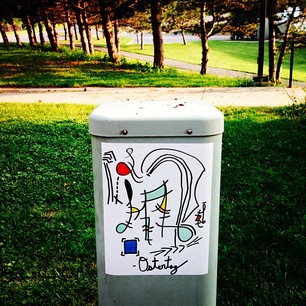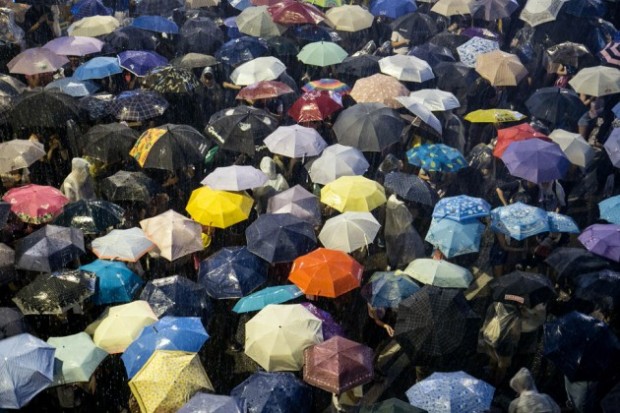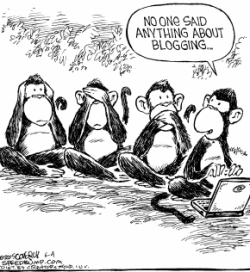 Some of the most influential books, sayings, poems of all time were published with no name. They are out there, on people’s bookshelves, framed on walls, quoted in movies, with no one to claim them. They transcend without ownership. This concept is easily applicable in relevance to the anonymity of street art and what it means to typical art culture and viewing practices. Much different than traditional art and even early graffiti, the anonymous works that are found on construction walls, street corners, and shop grates rather than hung in museums, and pose a difficult yet exciting complex for the street art, or, art-history enthusiast that happens upon them.
Some of the most influential books, sayings, poems of all time were published with no name. They are out there, on people’s bookshelves, framed on walls, quoted in movies, with no one to claim them. They transcend without ownership. This concept is easily applicable in relevance to the anonymity of street art and what it means to typical art culture and viewing practices. Much different than traditional art and even early graffiti, the anonymous works that are found on construction walls, street corners, and shop grates rather than hung in museums, and pose a difficult yet exciting complex for the street art, or, art-history enthusiast that happens upon them.
Often hilarious, poignant, or simply gibberish, anonymous street art works, whether wheat-pasted, spray-painted, hand-painted or a combination of all three, project a purity of artistic expression, singularly representing art for art’s sake. On the other hand, they may lack a point whatsoever, which is an idea equally as intriguing. No matter the case, they remind society of the freedom of art, how it can mean everything or nothing at all. It is absent of profit, of fame, of definition, it exists for the sake of self expression.
Thinking about the impact of anonymous street art can warrant a tremendous amount of varied, and maybe even contradictory thoughts, which may come out as a jumbled mess with no end. Like anonymous street art itself, no conclusion can truly be made or question answered. Street art, in a way, demands to be felt. It demands to be noticed. It provokes thoughts in every person that wanders down a street and come across a beautiful piece of art near some bags of garbage.
 First, what exactly is anonymous street art? It is simply impossible to determine an exact definition. If one were to Google “anonymous street art,” the first two pages are filled with various articles on Banksy. Is Banksy really anonymous? Nobody knows his (assuming it’s one person) real identity, yet, he has become enough of a celebrity that many argue that his work, which was first created illegally, should be protected or preserved. Clearly, Banksy is not anonymous in the traditional use of the word, but in the street art culture, he invented it. The style of his art revolves around his hidden identity and his signature, a route which many street artists have copied. Both Keith Haring’s subway drawings to Shepard Fairey’s OBEY were anonymous until they were discovered. Perhaps that is the idea after all, a game avoiding discovery.
First, what exactly is anonymous street art? It is simply impossible to determine an exact definition. If one were to Google “anonymous street art,” the first two pages are filled with various articles on Banksy. Is Banksy really anonymous? Nobody knows his (assuming it’s one person) real identity, yet, he has become enough of a celebrity that many argue that his work, which was first created illegally, should be protected or preserved. Clearly, Banksy is not anonymous in the traditional use of the word, but in the street art culture, he invented it. The style of his art revolves around his hidden identity and his signature, a route which many street artists have copied. Both Keith Haring’s subway drawings to Shepard Fairey’s OBEY were anonymous until they were discovered. Perhaps that is the idea after all, a game avoiding discovery.
So the question remains, at what point does a street artist stop being anonymous? Is all street art anonymous until it becomes more popular? It seems impossible to truly define what is anonymous street art.
But maybe that’s not the point. Perhaps anonymity comes as a result of artists not wanting to be discovered. Perhaps living in the shadows allows an artist to release all inhibitions and truly self express without being hindered by definition.
Coming across an anonymous piece of street art provokes a certain surge of excitement, finding something new that perhaps no one else has ever seen. Without the artist’s identity, without a date, the work seems mysterious as if it just appeared there by itself. In a world where throughout art history, the work is s0 intricately connected to identity, viewing anonymous street art is an almost liberating, new experience that revolutionizes art and the culture associated. .
For example, when art is discussed in school, students are taught to memorize the artist’s name, title of the work, and date. For art-history, the identity of the artist is integral to understanding the work and how the artist’s work progresses over their life or in relation to the different art historical movements.
One of the pivotal reasons that anonymous street art appeals to so many people is its backlash, or rebellion against the historical art-viewing process. Many indoctrinated art history students and teachers express they have a tough time processing these anonymous street works, and many of them, as a result, are leaders in efforts to discontinue street art overall. Barring the fact that street art is still widely ignored by universities, the anonymity of the artist is a concept still adamantly rejected by professionals in the art industry.

That being said, imagine if all of art history was taught without the identity of the artist. Suddenly, all of art would be open to wider interpretations without being stuck in a meaningless cycle of artistic movements and personalities. A whole new world of limitless meaning is created without the boundary of a “right” answer. Anonymous street art radically poses the question of how much an artist’s identity really matters to art-viewing.
Separate from both legal art and graffiti, anonymous street art sets up a complex relationship with the viewer who wants to both appreciate the work and find out who the artist is. But in the end, does it matter if the artist’s name is known? What does one get from a name? There are those who may obsessively try to figure out who did the work and where they come from, but for some, the art is enough and the anonymity is part of the masterpiece.
I’m lucky enough to know an anonymous street artist personally. His work can be seen in and around a multitude of cities in multiple countries to which he bears no credit, no permanent ownership, no control over his audience. To him, and others like him, his real-life Clark Kent/Superman-esque secret is far more important than any of that.
The name is Ostertag.
*Disclaimer: I will refer to the artist as “he” throughout this article in order to respect the artist’s wishes to remain anonymous.
This street artist thrives off random thought, impulse, and his incredibly unique pattern making talent. Ostertag is a collection of stickers, in various sizes and shapes, some typed, some individually marked splashed around cities on poles, bike stands, walls, mailboxes, nearly any blank space he can find, really.
The simplicity of his simultaneously intricate work is remarkable. His work is absolutely unmistakable and hard to miss. An original Ostertag design will either read a certain, quirky random message, or will leave viewers staring, trying to decode a hidden message/language impeded in the patterns. His work is impossible to replicate, not one design is like the next, which is what makes these designs, or any art for that matter, so impressive. Ostertag’s casual approach to displaying his designs, is emblematic of the true essence of street art. A rebellion against pretension.
It wasn’t until I met this artist when I really understood the thrill and excitement of street art. How it is a lifestyle, a passion, a whole secret world, and at the same time one can have an entirely separate identity void of art of any kind. Lawyers, doctors, janitors, just about anyone could have one occupation and life and be a world famous street artist at the same time without anyone knowing.
Leaving a piece of you somewhere is a privlage unlike anything else and that’s exactly what street art is: the ability to leave ones own, personal mark on the world. Whenever I visit this artist I take some stickers with me that, in efforts to spread his work, he lets me post them along my many travels wherever I wish.
I’ll never forget walking down the streets of Paris last month, a city I’d never visited before, and doing a double-take after seeing an Ostertag sticker on a brown pole in the middle of the street. I knew I was walking where Ostertag once walked and that, to me, was when I finally understood what street art is capable of making one feel. It makes one feel a connection, a sense of ownership of unchartered territories, a sense of belonging, a feeling of influence, an unrivaled ability to touch lives, something every human longs for.

Ostertag kindly offered to do an exclusive interview for “Streetheart” last week. Of course, the interview had to be conducted using only audio in order for Ostertag to continue his anonymous crusade around the world leaving his mark on every street corner and street sign for years to come.














